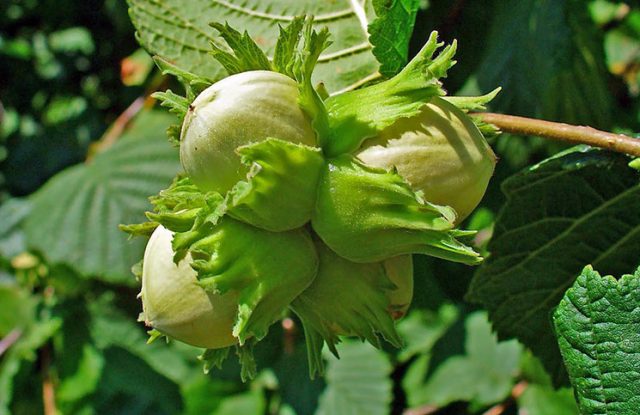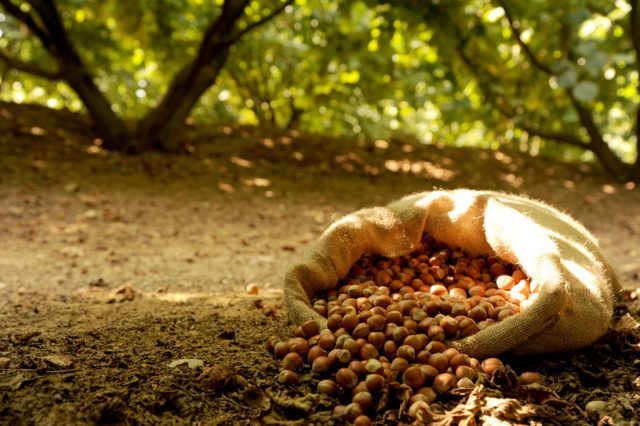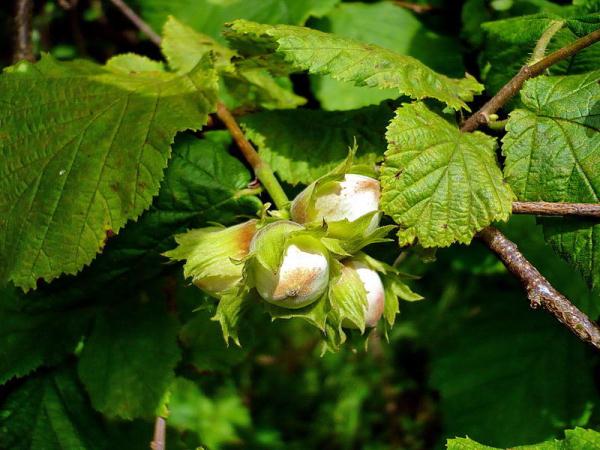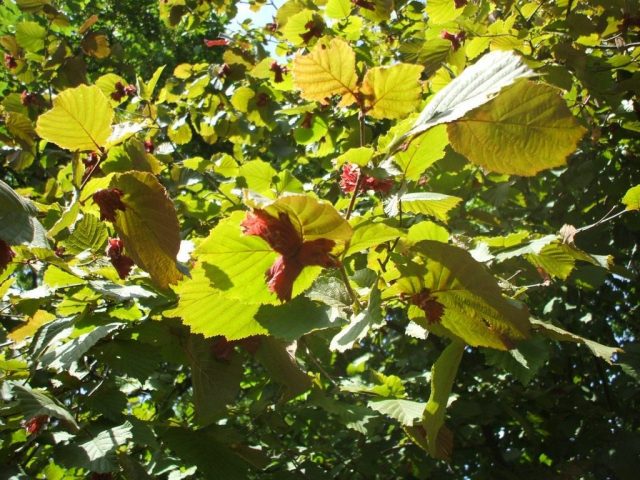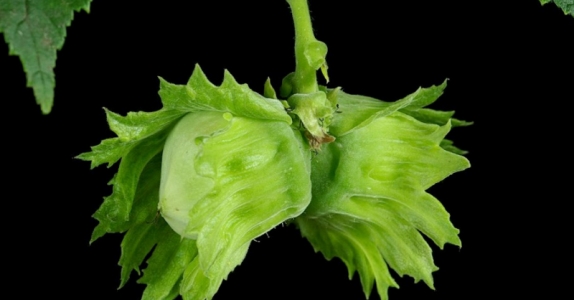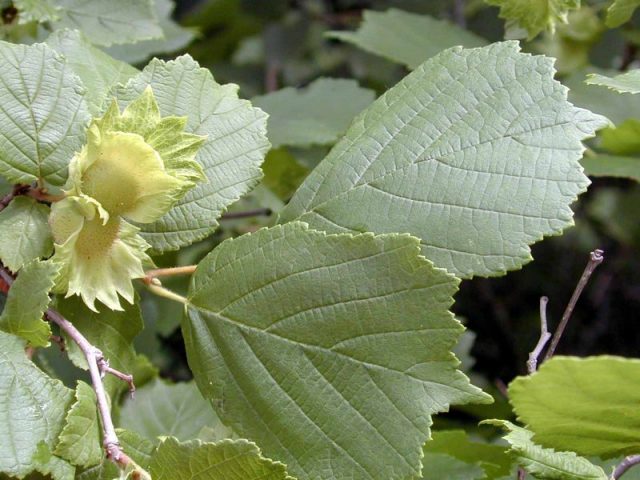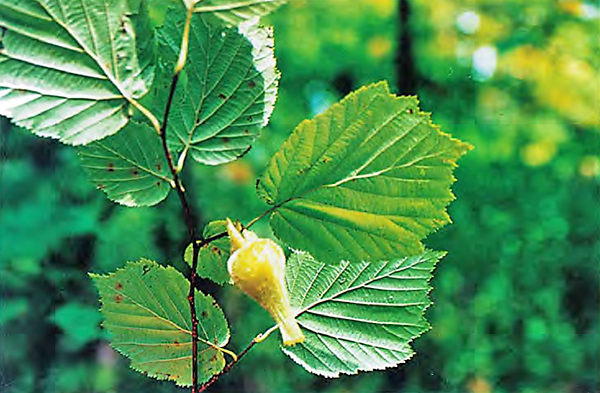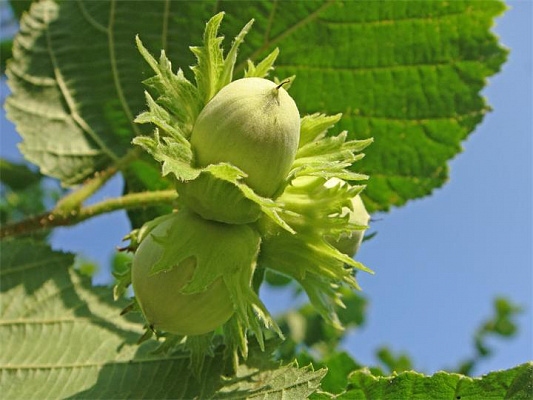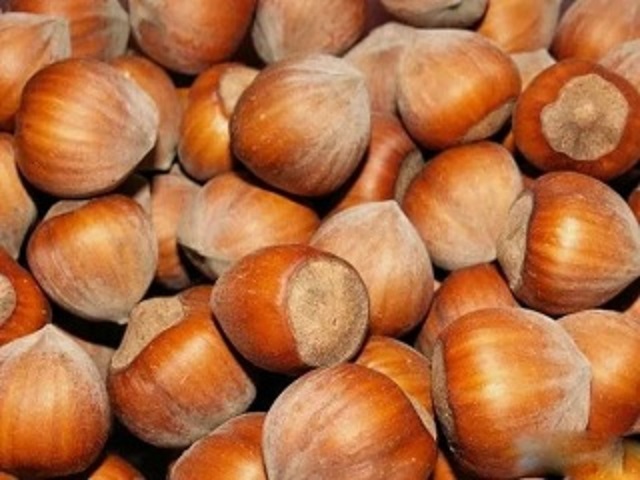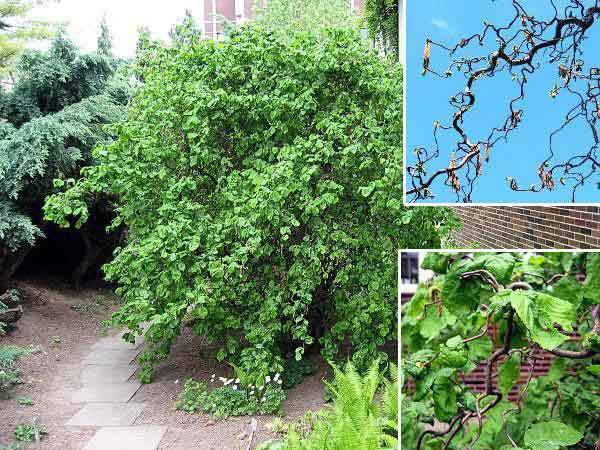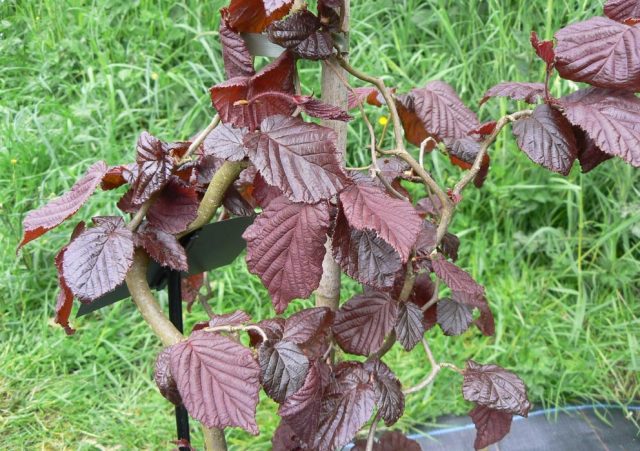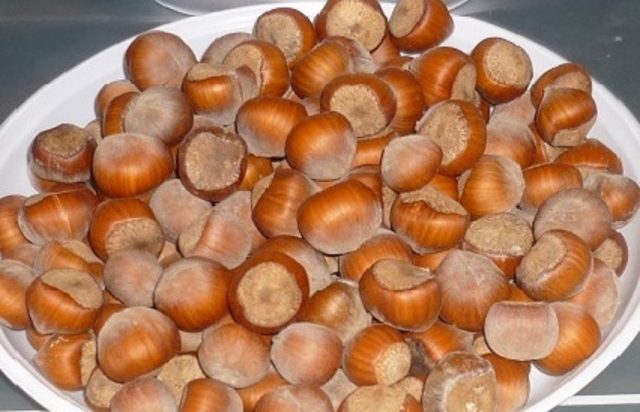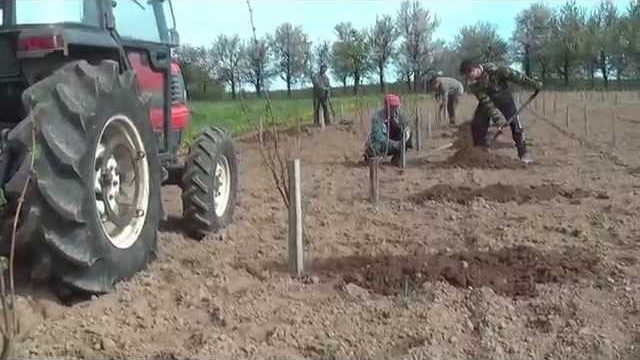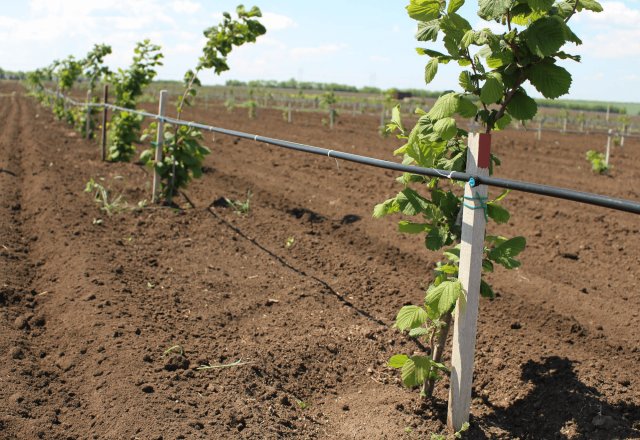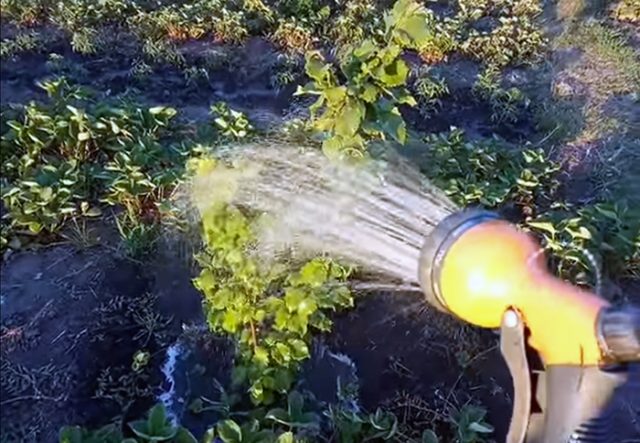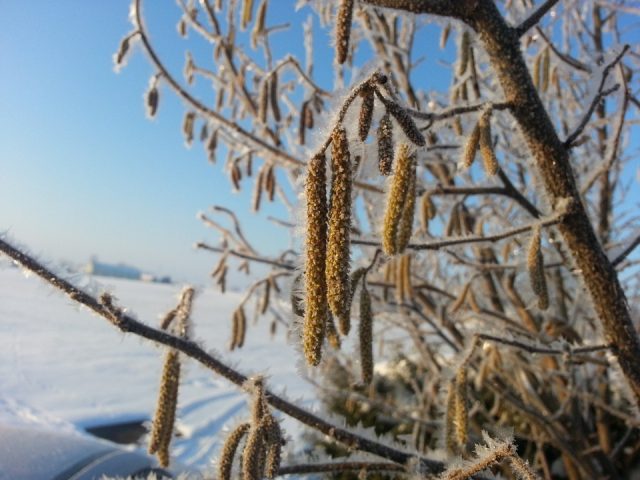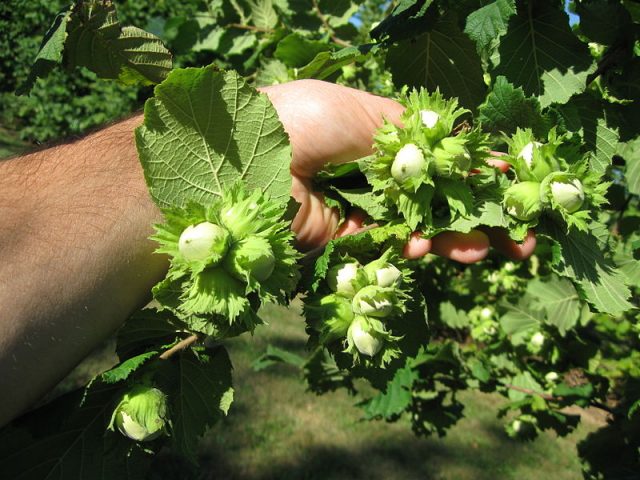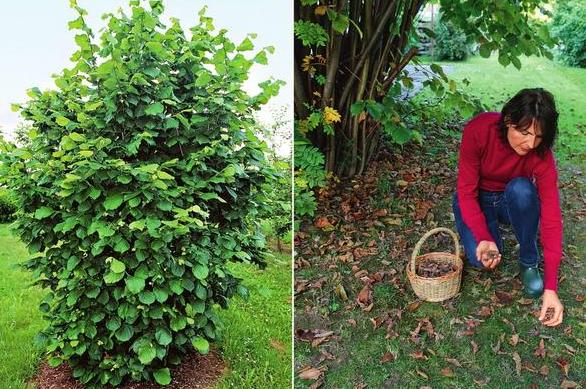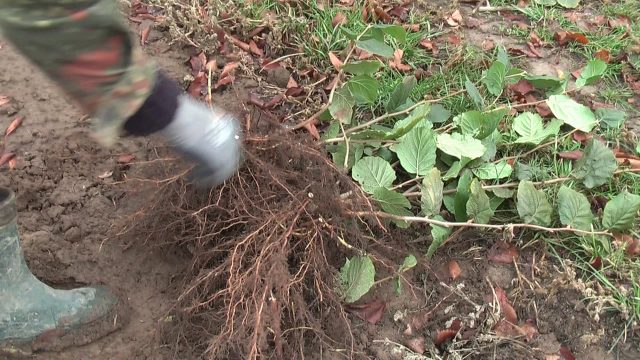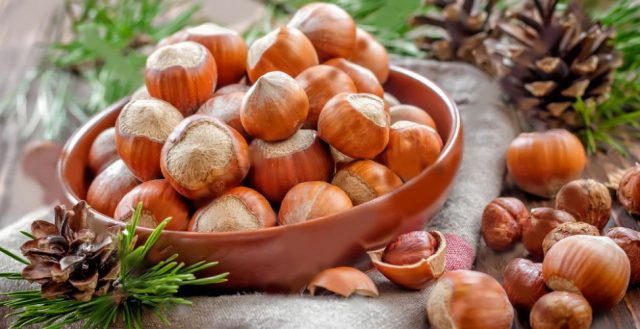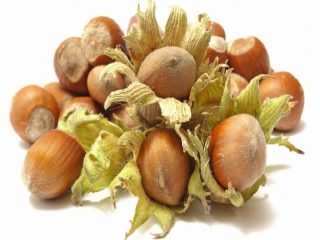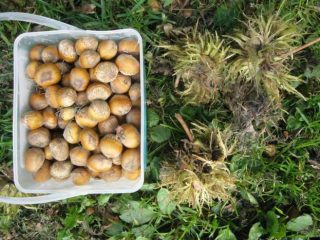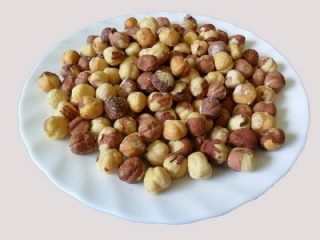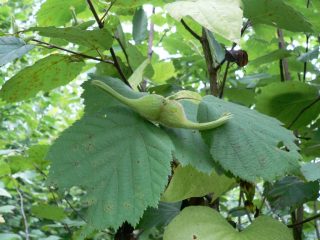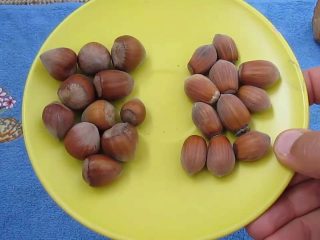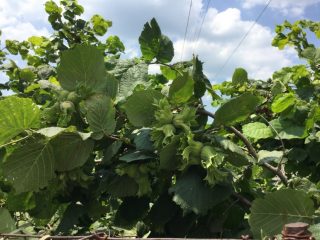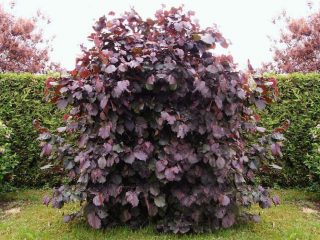Content
- 1 Botanical description of hazel
- 2 Popular types and varieties
- 3 How to plant hazelnuts
- 4 How to care for hazelnuts
- 5 Features of growing and caring for hazel in different regions
- 6 Hazelnut pollinators
- 7 When do hazelnuts begin to bear fruit?
- 8 Harvesting
- 9 How to propagate hazelnuts
- 10 How to grow rootstock for grafting hazelnut cuttings
- 11 Growing hazelnuts as a business
- 12 Conclusion
Cultivated varieties of hazel or hazelnuts, the care and cultivation of which have been practiced for thousands of years, are grown on an industrial scale in countries with mild climates.In cold regions, they used to be content with smaller hazelnuts, which grew in abundance in clearings and forest edges throughout Europe, the Middle East and the Caucasus. In the second half of the 20th century, hazelnut varieties appeared that could bear fruit even in the North-West.
Botanical description of hazel
Hazel (Corulus) or Hazel is a genus of deciduous shrubs or small trees belonging to the Birch family (Betulaceae). It consists of 20 species, 7 of which grow in the countries of the former Soviet Union. Large-fruited varieties of hazel are called hazelnuts and are planted in private gardens and on industrial plantations as a nut crop. In nature, hazel grows in clearings or as undergrowth, forming impenetrable thickets.
The Hazel genus includes shrubs 2-7 m high or small trees up to 10 m with light wood, smooth bark and flexible branches. Depending on the type, the crown can be spreading or compressed, compact. Hazel leaves are quite large, round or broadly oval, simple, serrated along the edges, often pubescent. The tip is sharp, and the veins are clearly defined and depressed, making the surface appear corrugated.
All types of hazel are monoecious plants with heterosexual flowers. Male catkins are located in the axils of the leaves. They appear on hazel shoots that have grown this year in June-July, but do not bloom until the new season. Female inflorescences are formed in buds located on the sides or on the tops of annual branches, from which only pinkish pistils peek out.
Hazel blooms in early spring, before the leaves bloom. Depending on the region, the nuts ripen from July to September.They can have a spherical or elongated shape and a brown color of different shades - from almost yellow to dark chocolate. The nuts are surrounded by a cup-shaped bed - plus, grow singly or are connected in 2-5 pieces.
The crop bears fruit unevenly. Prolific years alternate with seasons when there are very few nuts. Bushes of varietal hazelnuts and wild hazel grow greatly in width and become difficult to care for. Therefore, the average lifespan of an industrial plantation is 75 years.
Popular types and varieties
Hazel is a nut-bearing genus of shrubs and trees, widespread in North America, Asia and Europe. Various species grow in warm climates and reach the Arctic Circle. Hazelnuts, which are a cultivated large-fruited form of hazel, were previously planted mostly in southern countries and regions, but modern science has helped to develop new cold-resistant varieties.
Types of hazel
For domestic gardeners, hazel is of interest, growing in cool climates or used to create hazelnut varieties. Russia is the natural habitat of several species. All of them produce edible nuts and can be grown on industrial plantations and private gardens, some are endemic.
Common Hazel or Hazel
This type of hazel has a wide range - it grows in Italy and northern Norway, and feels great in any climate. It is a deciduous multi-stemmed shrub up to 5 m high. Hazel is distinguished by light gray smooth bark and flexible branches, densely covered with large soft leaves, pubescent on the reverse side.
In the south, Hazel Ordinary blooms in February, near St. Petersburg - from late April or early May. Spherical or oval, collected in groups of 2-5, hidden in a large bunch, brown nuts 18 mm long and up to 15 mm wide, ripen by August or September.
The hazel tree lives up to 90 years, produces about 900 kg of fruit per hectare, and is used in ornamental gardening. It is from Common Hazel that most varieties of hazelnuts are bred.
Large hazel or Lombard nut
This heat-loving species took part in the creation of many varieties of hazelnuts. Under natural conditions, Hazel Large grows in Southern Europe and Asia Minor; it thrives in the Crimea and Transcaucasia.
It is a tree-like shrub 3-10 m high with ashen bark and reddish-green pubescent young shoots. Nuts of Hazel Large - cylindrical or oval, up to 2.5 cm long. Blooms in March, nuts ripen by September.
Hazel Pontic
This heat-loving species was included in the list as the ancestor of most Turkish, Caucasian and south-eastern European hazelnut varieties. Pontian hazel is a shrub with rounded leaves and large flattened nuts, collected in groups of 2-3, surrounded by a wide open plus. Grows up to 6 m.
Hazel Varifolia
A multi-stemmed nut-bearing shrub, 1.5-2 m high, with an ovoid or spherical crown, widespread in the Far East. Hazel tolerates shade, low temperatures and grows on a variety of soils, including poor or dense soils.
The nuts are round, flattened on top, with a thick skin, surrounded by a velvety large plush, collected in groups of 2-3 at the ends of young branches. Their diameter is about 1.5 cm.Hazel blooms in early spring, about a month before the leaves bloom; the nuts ripen in September.
Hazel Manchurian
It is a shrub up to 4 m tall, common in the Primorsky and Khabarovsk Territories, Amur Region. Under natural conditions, Manchurian hazel grows exclusively as undergrowth. In cultivation it forms a tall bush with erect branches and oval leaves. Hazel can withstand frosts down to -45° C.
Pointed nuts with a thin shell are surrounded by a tubular plus, significantly larger than the size of the fruit. The hazel harvest is harvested in September.
Tree Hazel or Bear Nut
It is a tree more than 20 m high and a trunk with a diameter of about 50 cm. Individual hazel specimens can reach a height of 30 m and a thickness of 90 cm. It is distinguished by its light bark and narrow crown. Tree hazel is common in mountainous areas and on the Black Sea coast of the Caucasus, Transcaucasia, and the upper reaches of the Kuban River.
It grows slowly, begins to bear fruit late, lives up to 200 years, rarely gets sick, but produces a meager harvest. Hazel nuts are collected in 3-8 pieces, flattened on the sides and have a very hard, thick skin. The plus is pubescent and large.
This species is of interest as a wood-producing crop and as a breeding material. When crossed with common hazel and large-fruited hazelnuts, excellent varieties have been created that produce high-quality nuts.
Hazelnut varieties
Hazelnut is not a form of hazel, but a collective name for its large-fruited varieties. They differ in comparison with species by greater productivity. Heat-loving varieties have been known for more than 2 thousand years. Recently, resistant to low temperatures have been created, which make it possible to grow hazelnuts in central Russia and even in the North-West.There are forms with red and green leaves.
Cherkessky 2
Local Adyghe variety of hazelnuts, created in 1949. Adopted by the State Register in 1959, the originator was the North Caucasus Federal Scientific Center for Horticulture, Viticulture and Winemaking.
This hazelnut ripens early, and its resistance to pests, diseases, frost and drought is average. The variety is grown in the North Caucasus region.
Hazelnuts form a strong, spreading bush, reaching a height of 4 m and a width of 6 m. The nuts are universally used, flattened, pointed, with an average weight of 1.6 g, with a large solid top and a thin brown shell.
The taste rating is 4.5 points, the kernel yield is 45.2%, the hazelnut yield is up to 22.3 kg per hectare. The variety is recommended for industrial cultivation.
Contorta
An ornamental variety isolated in 1860 by the English gardener Kenon Ellacombe from an accidentally mutated common hazel bush. Further selection was aimed at consolidating the original shape of the shoots, leaving the nut harvest unattended.
The hazel variety Contorta is a shrub 1.5-2.5 m high or a tree up to 4.5 m, with a dense spherical crown with a diameter of 1.5-2.5 m. Curved and twisted shoots are intertwined. The asymmetrical dark green leaves of hazel are wrinkled, deformed, with pubescent, pronounced veins, and change color to yellow in the fall. The growth rate of the variety is slow, the bush increases by 25 cm every year.
Fruiting is rare, the nuts are edible. The variety tolerates shade and grows on any soil. Planting and caring for Contorta hazel is impossible only on acidic soils. It is recommended to include heavy pruning in the variety care package.
Red Majestic
A red-leaved ornamental variety created by the hybridization of Common Hazel and Large Hazel. It grows up to 3 m, the thick spreading crown reaches 3 m in diameter. The hazel branches of this variety are curved and twisted. The leaves are red-purple in the sun, green with a purple tint in the shade.
Hazel nuts are small, red-brown, edible, single or collected in 2-4 pieces, completely buried in a red tubular plus, ripen in September-October. Pollination with other varieties or species of hazelnuts and hazel is recommended.
The variety is winter-hardy, tolerates temperatures down to -34° C, shelter is needed only in the first years after planting. The tops of young shoots may freeze after a particularly harsh winter, but in the spring they quickly recover.
Planting and caring for Red Majestic hazel is recommended in well-drained soils as a single focal plant or as part of large and small landscape groups.
Trebizond
The hazelnut variety meets the best international standards, has been known for a long time, but was accepted by the State Register in 2017. Originators: V. G. Volkov and R. V. Fursenko.
Hazelnut Trebizond forms an erect bush 3-3.5 m high with a rounded crown of medium density. Large, one-dimensional, blunt-ended nuts of the variety with a flat base, the average weight of which reaches 4 g, ripen in an average period. The hazelnut top, consisting of two parts, is large and tightly covers the fruit.
The dense, creamy pulp of the nut is sweet and received a score of 5 points. The kernel yield is 48%, the yield is about 25 centners per hectare. Planting Trebizond hazelnuts is recommended throughout the Russian Federation.
How to plant hazelnuts
Hazel is an unpretentious crop that grows and bears fruit well on different soils.Its cultivated large-fruited varieties, called hazelnuts, are also not very demanding in terms of soil or planting location.
Landing dates
You can plant hazel on the site in spring and autumn. The main thing is that the soil is warm and moist at this time. Hazelnuts are planted in the spring at the same time or a little later with the beginning of field work, so that by the time the leaves open, the seedlings take root. In the fall, excavation work must be completed no later than 20 days before the first frost, otherwise the hazel may not survive.
Selection and preparation of a landing site
Unlike other crops, hazelnuts and hazel are less demanding on soil or topography. They can be grown even on steep slopes after creating terraces, or simply by digging holes. For planting hazelnuts, western, northwestern, northern, northeastern and eastern slopes are used. The southern side of the hills is not suitable for growing the crop - there hazel suffers from lack of moisture, spring frosts and blooms prematurely.
For planting and caring for hazelnuts in open ground, any soil is suitable, except dry sandy, swampy or saline. But the culture gives preference to humus-carbonate soil. Groundwater should not lie higher than 1 m from the surface.
Care must be taken to protect the hazel from strong winds. Although the hazelnut root system is superficial, it is strong and well-branched enough to stay on mountain slopes and not be uprooted during worsening weather. But in open areas, the wind interferes with the pollination of hazel and knocks off the ovaries and nuts.
When growing hazelnuts, sufficient illumination of the area is of great importance. In the shade the bush will not die, but it will bloom poorly and produce few nuts. Red-leaved hazelnut varieties will lose their decorative properties.
When growing hazel in the country, previous crops do not matter. When planting in spring, the soil is dug up in the fall, and vice versa. If the hazel tree is planted on a slope with a steepness of more than 10°, they dig holes 1-1.5 m deep and wide, or build terraces no less than 6 months in advance. They should not be horizontal, but have a reverse slope of 3-8°. Planting holes for planting hazel or hazelnuts in flat areas are dug with a depth and diameter of no less than 50 cm.
Acidic soils are limed at the rate of 500 g per 1 square meter. m. On chernozems, sand and humus should be added under the hazel to improve aeration.
Seedling preparation
Hazelnut seedlings with a closed root system take root better. They cost much more than dug ones, but they can be planted all spring or autumn, even with the leaves blooming or not yet having time to fall.
When purchasing hazelnut seedlings with an open root system, it is better to be personally present when they are dug up. If this is not possible, you should pay attention to ensuring that the buds are in a dormant state - this will make it more likely that the hazel will take root without problems. You need to carefully examine the hazelnut root.It should be fresh, intact, well developed and overgrown with a large number of fibrous processes.
Before planting, the container plant is moistened, but not too much, but so that it can be easily removed. A hazelnut seedling with bare roots is soaked in water with black soil for at least 3 hours. You should not put it in a clay mash. If the hazelnut root has been damaged, it is cut back to healthy tissue. Too long shoots are shortened.
How to plant hazelnuts
Before planting hazel, prepare a fertile mixture of topsoil and humus. Lime is added to acidic soils, and dense soils are improved with sand. There is nothing complicated about planting hazel:
- 2 weeks before the start of excavation work, the planting hole is filled 2/3 with a planting mixture mixed with fertilizers - 150 g of superphosphate and 5 g of potassium salt.
- The day before, the hazelnut ditch is completely filled with water.
- A mound is placed in the center of the pit, and a peg is driven in a little to the side.
- A hazelnut seedling is placed on a hill, the roots are straightened and covered with planting mixture. It is necessary that the near-trunk circle is below ground level, but not to deepen the root collar.
- The soil is compacted, 2-3 buckets of water are poured under each hazelnut bush, and mulched.
- The seedling is pruned, leaving 5-6 buds.
Hazelnut planting scheme
The technology for growing hazelnuts provides for a planting pattern of 8x8 or 8x7 m, on steep slopes - 6x6 or 5x5 m, and exclusively in a checkerboard pattern. Deviation from the specified plan is allowed.On rich soils, a larger feeding area can be left for hazel, and on poor soils, a smaller one.
How to care for hazelnuts
Hazel bears fruit well in the natural conditions of different climatic zones. With the development of nut-bearing hazelnut varieties, the crop, although it has become more whimsical, still remains a “plant for the lazy.”
Loosening the soil is of great importance when caring for hazel. It should not be forgotten that most of the roots lie at a depth of 10-35 cm, only some go down to 1 m. In hazel, shoots thicker than 3 cm are poorly regenerated. Therefore, loosening should be regular, but tree trunk circles should be processed to a depth of no more than 6-8 cm.
Watering and fertilizing hazel
Hazelnuts need regular watering. Without this, many empty nuts are formed, the percentage of kernel yield decreases, and the yield drops by half. Product quality also suffers.
Depending on the region and weather, hazel is watered 1-2 times a month. Mandatory moisture recharging is carried out several times per season:
- immediately after flowering;
- in May;
- in June;
- twice in July, when the hazel kernels are filled and next year's fruit buds are laid;
- after leaf fall.
Air humidity is of great importance for hazel - it should be high. If the site has sprinkling or a fog-forming installation, no problem. Other gardeners can hose down the hazelnuts once a week. It is necessary to spray the stream in such a way that the water pressure does not knock down the nuts; sprinkling is carried out in the afternoon or in cloudy weather.
If the hole was filled with fertilizers when planting hazel, they begin to feed it after 3 years. Every autumn, the tree trunk circle is mulched with compost or humus with the addition of ash. In the spring, 100-150 g of nitroammophoska is embedded in the soil under each bush, and during the formation of the ovaries, the hazelnuts are additionally fertilized with urea.
On chernozems and soils rich in nutrients, do not apply additional doses of nitrogen - this will cause rapid growth of the above-ground part to the detriment of fruiting. In addition, the hazelnut shoots will not have time to ripen before the end of the season and will certainly freeze. Hazel will receive all the necessary elements from organic matter and ash.
On soils that are too poor, it makes sense to carry out additional fertilizing not with urea, but with slurry. For this:
- The barrel is filled 1/3 with fresh manure.
- Add water.
- Leave the mixture to ferment in the sun for 2 weeks.
- The contents of the barrel are stirred daily with a long stick.
- The fermented slurry is diluted 2 times with water and watered over the hazelnuts. For each adult bush, 3-4 buckets are used.
A good result is obtained by spraying hazel leaves with urea or other nitrogen fertilizers. This is called flash feeding and can be done every 2 weeks until the end of June - beginning of July.
Trimming and shaping
The point of formative pruning of hazelnuts is to get a bush that has 8-10, but no more than 12 skeletal trunks, growing as far apart as possible. They should be evenly spaced in all directions.
Usually, a high-quality hazel seedling develops a bush on its own; the gardener’s task is to promptly remove weak and thickening skeletal branches.If root shoots are weakly formed 2-3 years after planting hazelnuts, the entire above-ground part is cut off at a level of 6-8 cm from the ground. The next season, a lot of seedlings appear, which are allowed to grow freely, and in the second or third spring the excess ones are removed, leaving the strongest and best located ones.
Further pruning of hazel involves removing excess shoots that appear at the base of the bush and dry shoots. One-year-old branches cannot be shortened - it is on them that male catkins and female flowers are formed, ensuring the next year's hazelnut harvest.
Hazel rejuvenation begins when the yield decreases. This usually happens no earlier than after 20-25 years, even in the absence of care. Total pruning is carried out only on heavily overgrown and neglected hazel trees. Well-groomed hazel is gradually rejuvenated.
Protection from diseases and pests
The main protection of hazelnuts from diseases and pests is proper agricultural technology and preventive spraying with colloidal sulfur and copper-containing preparations. Dense hazel plantings are a breeding ground for infection; they are inconvenient to care for and impossible to treat with chemicals.
Most often, hazelnuts get sick:
- powdery mildew;
- brown leaf spot.
Of the hazel pests, the following should be highlighted:
- nut weevil;
- walnut barbel;
- catkin gall midge;
- aphid;
- scale insect;
- bedbugs.
Hazelnuts and other pests are affected during the period of mass reproduction. To protect the hazel tree, it is necessary to loosen the tree trunk circles by 6-8 cm in spring and autumn. The row spacing needs deeper treatment.You can destroy pests on hazelnuts using insecticides.
Preparing for winter
Hazel has good frost resistance if grown in regions where the climate is similar to the species' natural habitat. She doesn't need shelter.
If you plant hazelnut varieties in accordance with their frost resistance zones and according to the rules of agricultural technology, you only need to insulate the seedlings in the first year. What is scary for hazel is not so much negative temperatures in winter or during flowering, but even a slight minus after pollination. To preserve hazelnut ovaries, smoke and cover the plantings with agrofibre or lutrasteel.
Features of growing and caring for hazel in different regions
It is easiest to grow hazelnuts in regions with warm climates. Care there is minimal, and the choice of varieties is huge.
Growing hazel in the Urals
Common hazel and other winter-hardy species common in cold regions of Russia grow in the Urals without any problems. But the male catkins of hazelnut varieties may freeze - they form in June or July of the previous year, overwinter on young shoots, and open in the spring. If frost damages the shoots, they recover quickly, and the flowers no longer produce pollen.
To prevent this from happening, you need to choose hazelnut varieties that are resistant to cold. Among those included in the State Register are:
- Academician Yablokov;
- Ivanteevsky Red;
- Cudraif;
- Moscow Rannmiy;
- Moscow Rubin;
- Firstborn;
- Purple;
- Sugar;
- Tambov Early;
- Trebizond.
For pollination to occur, male flowers must be preserved at all costs.To do this, hazelnut branches with male catkins are bent to the ground in the fall and secured. You can simply place a stone on a branch. The snow will cover the shoot, and the earring will survive.
In the spring, the load is removed, the flexible hazelnut branch straightens and returns to its previous position. True, there is a danger that there will be no snow, or the catkin will dry out in the shelter. But pollination does not require many male flowers. It is enough to tilt several branches with earrings from each hazelnut variety - then the likelihood that at least something will be preserved increases.
Otherwise, planting and caring for hazelnuts in the Urals is no different from other regions.
How to grow hazelnuts in Siberia
The State Register contains hazelnut varieties recommended for cultivation throughout Russia. There are no such ones that are intended specifically for Siberia. Common hazel, which became the ancestor of most hazelnut varieties, does not grow there under natural conditions.
It is generally irrational to plant and care for Common Hazel in Siberia. They have their own species, for example, Manchurian and Varifolia, which produce enough nuts and grow without problems.
Varietal hazelnuts in Siberia have long been an imported product. But recently, the Barnaul Research Institute of Horticulture of Siberia named after. M. A. Lisavenko and an experienced gardener from Biysk R. F. Sharov created varieties specially designed for the region:
- Alida;
- Lentina;
- Biysk Zelenolistny;
- Biysk Krasnolistny;
- Biysky Sharova.
In Siberia, hazel is planted and cared for under the protection of fences or buildings, in places where there is a lot of snow in winter.The main problem when growing hazelnuts in this region is not that the bushes will not survive the winter, but that the catkins freeze out. You can save them using the method recommended for the Urals.
Planting and caring for common hazel in the Moscow region
Hazel and hazelnuts grow in the Moscow region without any problems at all. By some strange whim of nature, the capital and its surroundings are an island of the fifth frost resistance zone, surrounded by the colder fourth. Only the southernmost varieties of hazelnuts will not grow there. Those that live near Kiev spend the winter and require the same care in the Moscow region.
Hazelnut pollinators
The beginning of the hazel growing season is considered to be flowering, which occurs before the leaves bloom, when the temperature rises to 12° C. Hazelnut catkins lengthen, the anthers burst and yellow pollen fertilizes the female flowers with the help of the wind.
If during flowering the temperature drops to -6° C, this does not affect the hazel harvest. But after fertilization, cold temperatures down to -2-3° C are detrimental to the ovaries.
To obtain a good harvest, hazelnuts must be pollinated by other varieties or hazel. Even in private gardens, it is recommended to plant 3-4 varieties, despite the fact that the culture forms quite large bushes.
This is mainly due to the fact that often male and female flowers of the same hazelnut variety do not open at the same time. And then, even under favorable conditions, pollination does not occur.
For southern hazelnut varieties, good universal pollinators are:
- Cherkessky-2;
- Furfulak;
- Curly;
- Lombard red or white.
In regions with a temperate or cold climate, it makes sense to grow a common hazel bush in the garden, which perfectly pollinates varietal hazelnuts.In a small garden, you can simply graft the species onto one skeletal branch.
If there is time and opportunity, hazelnut pollination can be done manually. For example, keep pollen from male catkins at a temperature close to 0°, and when the female flowers open, transfer them to them with a soft brush.
It happens that male and female flowers open at the same time, but the weather is calm. Then you can help the hazelnuts by simply shaking the branches.
When do hazelnuts begin to bear fruit?
With vegetative propagation, hazelnut varieties begin to bear fruit after 3-4 years, grown from seeds - after 6-7 years. Hazel produces a full harvest at the age of 8 or 10 years. The skeletal branch lives for 2-2.5 decades, then dies or is cut out. The hazel bush is capable of renewing shoots for 80-90 years, under favorable conditions in the southern regions - up to 150-180 years.
Harvesting
Potentially, hazel should bear fruit annually. In the southern regions this is what happens - harvest seasons alternate with those when few nuts grow. In the northern regions, abundant hazel fruiting often occurs once every 6-7 years. This is mainly due to the freezing of flower buds or the non-simultaneous opening of male and female flowers.
Collection of fully ripe nuts
Hazelnuts are harvested as the nuts ripen. This happens when the top (wrapper) turns yellow and the fruit falls off. If you pick hazel nuts from a tree, there is a high probability that they have not had time to fully ripen and will not be stored for long. In addition, unripe hazelnuts do not gain enough fat, carbohydrates, and proteins. The kernels of such nuts are tasteless and small. Late harvesting of hazelnuts is fraught with the risk that the fruits will be stolen by birds, rodents and other “helpers”.In the worst case scenario, nuts that fall to the ground will begin to rot.
To make harvesting easier, the space under the hazelnut or hazel is cleared of plant debris and other debris. You can lay a tarp on the ground.
A small harvest of hazelnuts is manually cleared of hazelnuts, while a large harvest is threshed.
Harvesting nuts of technical ripeness
You can harvest hazelnuts by manually removing them from the bush at the stage of technical maturity, when the top has already turned brown and the nut has changed color to light brown or yellow, but has not had time to fall off. They do this in several passes, tearing off the fruits along with the wrapper.
The toppings from the hazelnuts are not removed, but placed in heaps, where they ripen and fermentation occurs. Then the tannins from the wrapper oxidize the shell and turn it dark brown, and give the kernels a characteristic taste.
Drying the nuts
The hazel fruits are dried in a ventilated area for 1-2 weeks, scattered in a thin layer. You can take them outside to a shaded place for a day, and put them away at night so that they do not accumulate moisture.
Nuts are ready for storage when their moisture content does not exceed 12-14%. This can be determined by the sound - a handful of hazelnuts is shaken, if a knock is heard, they are packaged in paper bags. At a temperature of 3 to 12 ° C in a dry place they will be stored for a year. Keeping it at 0-3°C will extend the shelf life of hazelnuts to 3-4 years.
To get roasted nuts, they are dried in the oven at 110°C.
How to propagate hazelnuts
Hazel and hazelnuts are propagated by vegetative or seed methods. When planting nuts, varietal properties may not be preserved or may not be fully transmitted.
Dividing the bush
For a private plot, this is the easiest way to propagate ungrafted hazelnuts, preserving all the characteristics of the variety.The old bush is dug up, all shoots are cut to a height of 15-20 cm, and divided into parts. Each must have at least one stump and part of the root.
By layering
This method also preserves the characteristics of the variety if the hazelnut has not been grafted. It is not much more difficult than the previous one, but it takes time. Hazelnut layering can be of three types.
Regular layers (arches)
From a flexible hazelnut shoot at a distance of 30 cm from the top, 2 cm of bark is removed opposite the bud, or an incision is made into which a match is inserted. The wound surface is powdered with a growth stimulator and instilled with the damaged side down to a depth of 8 to 15 cm. The soil is compacted and watered, the top is tied to a peg. Next season, the hazelnut seedling is transferred to a permanent place.
Vertical layers
The hazelnut bush is completely pruned in early spring, leaving stubs of 8 cm. New shoots will begin to grow, they are gradually covered with soil, leaving the tops on the surface. When the mound reaches a height of 20 cm, stop adding soil. Throughout the season, the hazelnut bush is watered abundantly, and next autumn it is divided and planted.
Horizontal layering
In the spring, before the leaves bloom, the top of a hazelnut shoot 120-150 cm high and 6-8 mm thick is cut off and placed horizontally in a groove 8-10 cm deep. The trench is not filled with soil, but the branch is pinned in several places. Shoots begin to grow from the buds, which are gradually covered with earth. By the end of the season, a mound about 10 cm high will form. Next autumn, the hazelnut shoot is dug up and divided into parts, each of which should consist of a shoot and a fibrous root.
Root shoots (residues)
Hazelnut and hazel shoots appear 2-3 years after planting in a permanent place.During its life, a bush can form from 80 to 140 root shoots. The weak ones are cut out, the strong ones are used for replacement shoots and hazel growth, but can be used for hazelnut propagation.
To do this, the best 2-3-year-old offspring are selected, separated from the mother bush with an ax or shovel, and torn out of the ground. Their root system is usually weak; seedlings are placed in a school for growing. In private gardens, hazelnut shoots can be immediately planted in a permanent place, 2-3 pieces per hole.
Vaccinations
To propagate hazelnuts by grafting, you need to have some experience - the cadmium layer of the crop is thin. Common hazel, variegated hazel and tree hazel (bear nut) are used as rootstocks. Cuttings are harvested in the fall and stored in snowdrifts.
In the spring, grafting is done in the cleft, in the butt, behind the bark. You can do copulation with an eye in the summer, and the scion should be cut no more than 24 hours before the operation. The grafting site is coated with garden varnish, tied and covered with polyethylene. After the scion and rootstock have fused, the cellophane is first removed, and after 2 weeks the fabric is removed.
All shoots are removed, shoots located below the grafting site are cut out.
Green cuttings
This is the most unreliable way to propagate hazelnuts. It is labor intensive and has a very low survival rate. The upper or middle part of the green cuttings is cut into pieces of 10-15 cm, the lower leaves are removed, treated with a root formation stimulator and planted in a cold greenhouse.
How to grow rootstock for grafting hazelnut cuttings
Grafting hazelnuts onto hazel makes it possible to breed especially valuable varieties, but it cannot increase the frost resistance of southern varieties.Even if the root is preserved without damage, the catkins will freeze in winter, and this is what has long hindered the advancement of the culture to the north.
The ideal rootstock for hazelnut varieties is Tree Hazel; it practically does not produce shoots, which makes care much easier. But the species does not grow well in cold climates. So it makes sense to do such vaccinations only in the southern regions.
Common hazel is a good scion that can be used in the European part of Russia and warm or hot Asian regions. Due to the peculiarities of the climate in the North and beyond the Urals, it is preferable (but not necessary) to graft hazelnuts onto Hazel Varifolia.
The best scion will be a seedling grown from a walnut in the area where the garden will be established.
Growing hazelnuts as a business
Industrial cultivation of hazelnuts is possible in areas unsuitable for other crops. Hazel will thrive on steep slopes, and if the terraces are made wide enough, mechanical harvesting is possible. On a large plantation, it is better to plant 5-6 varieties, and every 10 rows plant a strip of Common Hazel for cross-pollination.
Growing hazelnuts on farms, in addition to saving arable land, has a number of advantages:
- ease of storage and long shelf life;
- the average hazelnut yield is about 20 centners per hectare;
- ease of cultivation and low cost;
- high demand for hazelnuts both among the population and among processing enterprises;
- high cost of nuts.
Conclusion
Hazelnuts, which are easy to care for and grow, can provide a family with nuts or provide additional income even in small areas. Any gardener can easily cope with this crop and get a decent harvest.
